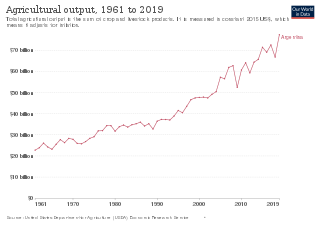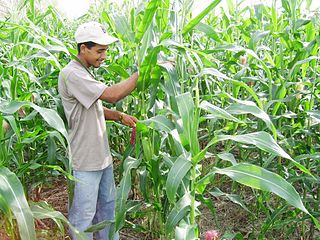Related Research Articles

This article looks at the economies of Manchukuo and Mengjiang, in the period 1931-1945. The effective Japanese annexation of 1931 led to a colonial system. Japan invested in heavy industry, and to a lesser extent, agriculture.

Agriculture in Cuba has played an important part in the economy for several hundred years. Today, it contributes less than 10% to the gross domestic product (GDP), but it employs about 20% of the working population. About 30% of the country's land is used for crop cultivation.
Four-digit postal codes were first introduced in Romania in 1974. Beginning with 1 May 2003, postal codes have six digits, and represent addresses to the street level in major cities. The digits represent the postal area; the county; the city/commune; the last three, depending on the size of the city/commune, represent the commune/city, the street, or the house/building.

Agriculture is one of the bases of Argentina's economy.

The agriculture of Brazil is historically one of the principal bases of Brazil's economy. While its initial focus was on sugarcane, Brazil eventually became the world's largest exporter of coffee, soybeans, beef, and crop-based ethanol.

Transelectrica is an electricity transmission system operator in Romania. It is publicly traded company with 58,69% of the shares being held by the Ministry of Economy and Commerce, 13,5% by Fondul Proprietatea, and 27,81% being floated on the Bucharest Stock Exchange or held by other investors. It is listed at the Bucharest Stock Exchange.
The Port of Constanța is located in Constanța, Romania, on the western coast of the Black Sea, 179 nautical miles (332 km) from the Bosphorus Strait and 85 nmi (157 km) from the Sulina Branch, through which the Danube river flows into the sea. It covers 3,926 ha, of which 1,313 ha is land and the rest, 2,613 ha is water. The two breakwaters located northwards and southwards shelter the port, creating the safest conditions for port activities. The present length of the north breakwater is 8,344 m (5.185 mi) and the south breakwater is 5,560 m (3.45 mi). The Port of Constanța is the largest on the Black Sea and the 17th largest in Europe.

Agriculture employs the majority of Madagascar's population. Mainly involving smallholders, agriculture has seen different levels of state organisation, shifting from state control to a liberalized sector.

The Roman Catholic Archdiocese of Bucharest is the Latin Metropolitan archdiocese in Romania.

Rice production in Thailand represents a significant portion of the Thai economy and labor force. In 2017, the value of all Thai rice traded was 174.5 billion baht, about 12.9% of all farm production. Of the 40% of Thais who work in agriculture, 16 million of them are rice farmers by one estimate.

Rice production in Laos is important to the national economy and food supply.

Agriculture in Panama is an important sector of the Panamanian economy. Major agricultural products include bananas, cocoa beans, coffee, coconuts, timber, beef, chicken, shrimp, corn, potatoes, rice, soybeans, and sugar cane.
Poland's agricultural sector is vital for European and Global market because it produces a variety of agricultural, horticultural and animal origin products. The surface area of agricultural land in Poland is 15.4 million ha, which constitutes nearly 50% of the total area of the country.
Regia Naţională a Pădurilor Romsilva or simply Romsilva is a Romanian state-owned enterprise responsible for dealing with protection, preservation and development of publicly owned forests of the Romanian state, and the management of hunting and fishing grounds. Romsilva owns and manages 4,000,000 hectares of forests which represents 65% of all forests in the country. The company has its headquarters in Bucharest.

The 1990 Vrancea earthquakes were three earthquakes on 30 and 31 May 1990 with magnitudes of 7.0 Mw and 6.2 Mw that struck the Romanian county of Vrancea, on two consecutive days. Severe damage in the Bucharest-Brăila-Brașov area was reported and dozens of casualties in Romania and neighbouring Moldova, Ukraine and Bulgaria.
Sugarcane is the only crop cultivated in Sri Lanka for manufacture of sugar. This crop can be growth on well drained soil up to an elevation of about 1,000 m (3,300 ft). Sugarcane has been cultivated in Sri Lanka since 19th century. About three decades ago, in the 1970s Sri Lanka was cultivated in about 25,000 ha. There were 3,840 ha in Kantale, 5,660 ha in Hingurana, 4,500 ha in Pelwatte, 4,680 ha in Seveanagala and 5,700 ha in Moneragala. At present, only Pelwatta and Sevanagala factories are functioning. Cultivation at Hingurana has started and it is likely that the factory will start production in 2010. Most of the lands cultivated with sugarcane are in the intermediate zone. Receiving annual rainfall of 1,250–2,000 mm (49–79 in) distributed in a bimodal pattern.
The 2019–20 Liga IV Teleorman was the 52nd season of the Liga IV Teleorman, the fourth tier of the Romanian football league system. The season began on 30 August 2019 and was scheduled to end in June 2020, but was suspended in March because of the COVID-19 pandemic in Romania.
The 2019–20 Liga IV Călărași was the 39th season of the Liga IV Călărași, the fourth tier of the Romanian football league system. The season began on 3 August 2019 and was scheduled to end in June 2020, but was suspended in March because of the COVID-19 pandemic in Romania.
The 2019–20 Liga IV Ialomița, also known as Liga IV Secomi Travel for sponsorship reasons, was the 52nd season of the Liga IV Ialomița, the fourth tier of the Romanian football league system. The season began on 24 August 2019 and was scheduled to end in June 2020, but was suspended in March because of the COVID-19 pandemic in Romania.
References
- 1 2 "Romania ar putea deveni unul dintre principalii producatori de orez din UE". EurActiv. August 2008. Retrieved August 30, 2010.
- ↑ "În Dolj, prima producţie de orez după 20 de ani". eComunitate. Retrieved September 2, 2010.
- 1 2 3 4 5 6 ""Macaronarii" preferă în România risotto!". Saptamana Financiara. April 2010. Archived from the original on July 16, 2011. Retrieved August 30, 2010.
- ↑ "World rice production" (PDF). ressources.ciheam.org. Retrieved August 30, 2010.
- ↑ "Renasc orezăriile de la Stăncuţa". Lumea Satului. Archived from the original on March 23, 2011. Retrieved August 30, 2010.
- ↑ "Cultivarea orezului, o afacere de succes". Ziare.com. Retrieved August 30, 2010.